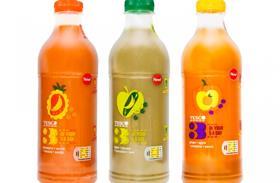
Remember when smoothies were the superstars of the healthy drinks sector?
Back in the pre-recession days of the early noughties, Innocent used cunning marketing to snare a fresh breed of ‘conscientious consumers’ and virtually created a whole new drinks category from scratch in the UK.
“Innocent launched in the UK in 1998, about four years after Pete & Jonny (P&Js),” explains Heidi Lanschuetzer, a senior food analyst at Mintel. “However, Innocent quickly overtook the brand largely thanks to its distinctive company ethos, the story behind the brand and its continuous focus on innovation.”
As Lanschuetzer points out, Innocent made humour an integral part of its marketing language, packed with daft mission statements and (genuine, it turned out) invitations to call them on the ‘banana phone’.
“It changed the way food and drink brands communicate with consumers and basically brought fun and brand values to commodity markets,” she says. Underneath all the wacky words was a serious health proposition too. Smoothies chimed with consumers seeking ‘a little bit of health’ and an easy way to achieve one of the government’s newly-minted 5 A DAY.
Yet all good things must come to an end, and for some consumers the halo began to slip for Innocent in 2009, when the founders agreed to sell an 18 per cent share to Coca-Cola.
Unfortunately for Innocent’s PR machine, social media was clogged up with consumers who felt betrayed that a brand which made a virtue of being small and quirky was beingsold to one the world’s biggest drinks companies.
The complaints fell on deaf ears, and Coca-Cola bumped up its share of Innocent to 90 per cent last year.
Buying the brand seemed like a smart move for Coca-Cola, a corporation whose carbonated drinks sales are losing their fizz in Europe, partly due to consumer worries about obesity. But, according to figures from Kantar Worldpanel, in 2013 smoothies aren’t the big draw they once were in Innocent’s heyday.
The Market Intelligence agency reckons that smoothies have lost 3.6 percentage points across the country. That might not seem like much, but it’s still 950,000 UK households that have crossed smoothies off their
shopping lists.
In fact, after a fairly decent 12 months in 2011, figures show that smoothie sales slumped by 11.2 per cent in 2012, mainly due to a fall in sales at Innocent.
So what’s to blame for this sudden decline? “One of the biggest challenges the smoothies market is currently facing is its poor value image,” says Lanschuetzer. “In fact, a striking two-fifths of users think that smoothies are not good value for money. In times of squeezed consumer budgets their comparatively high prices seem to put many consumers off buying them.”
Manufacturers are attempting to mitigate this move by putting products on promotion, but rising commodity prices mean that it’s going to be a struggle to keep RRPs under control. Plus, inflation isn’t likely to change anytime soon, with Mintel predicting that in value terms the biggest proportion of future growth will be due to increased prices.
The brands that have tried to offer permanently cut-price smoothies haven’t fared too well either, with Spanish juice company Don Simon pulling its £1.99 one-litre smoothie off the shelves last year after 18 months because of poor sales.
But most worrying for the smoothie sector is the way that the health lobby seems to be changing its focus away from fat to rebrand sugar as public enemy number one. “Fruit juice and smoothies have recently attracted attention from health organisations and charities for their high sugar levels, albeit naturally occurring, and their alleged contribution to obesity,” says Lanschuetzer.
In January 2014 Susan Jebb, dubbed the government’s ‘health tsar’ by the Daily Mail, made headlines with her claim that fruit juice’s high sugar content means it shouldn’t be counted towards 5 A DAY. And with juice in the firing line, it won’t be too long before smoothies take a direct hit.
Despite this doom and gloom Lanschuetzer says that innovation could put smoothies back on top. “Smoothie brands could look to fortification with vitamins, minerals or other nutrients, given the interest among more than half of users in variants that offer functional benefits,” she says.
“Meanwhile, manufacturers could make more of the inherent health benefits of vegetables. Promisingly, fruit-vegetable juice blends enjoy positive health associations among a large minority of users, with more than a third thinking that they are healthier than pure fruit juice.”
“Adding vegetables to smoothies is also one possible way to address the widespread concerns about smoothies’ sugar content.”
So will a switch to added vitamins and veg save the day? Maybe, but it could be a long hard slog for smoothies to get back on top in 2014.



